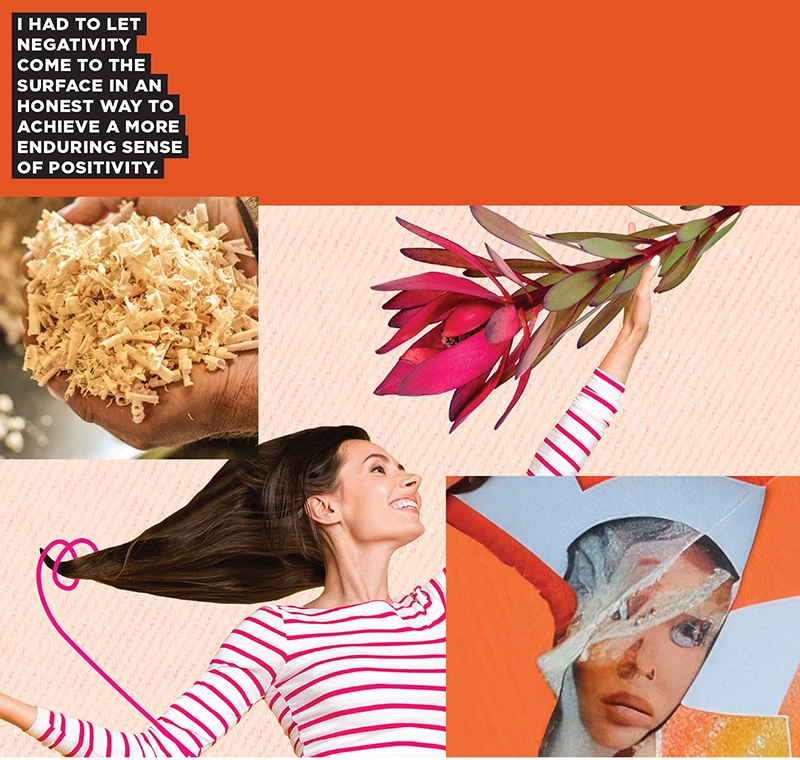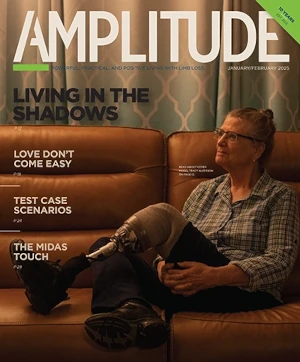Hiding negative emotions behind an artificially positive facade is supposed to be bad for you. But when I did this after limb loss, it actually helped…until it didn’t.
by Diana Theobald

As I write this, I’m deep in preparation for the LSAT, so everything looks like a multiple-choice question to me. Here’s how I’d present the subject of toxic positivity and limb loss, in standardized-test format:
Q: How are you today?
A. Blessed! Disability is a superpower! Let me recite all the ways in which I am thriving!
B. How am I? My socket doesn’t fit, my insurance won’t approve a new one, my liner farts with every step I take, and men are repulsed by my stump. My life is hell!
C. Fine. How are you?
At first, I assumed that toxic positivity is defined by A—the kind of obnoxiously perky greeting that makes you want to run away because you’re feeling rather unblessed and can’t hold a smile for longer than three seconds without feeling nauseous. But the more I looked into it, the more I realized that toxic positivity is defined less by picking A and more by rejecting B at all costs, especially when B is how you actually feel. And that brings us to C, the nonanswer that many amputees (including me) so often default to when we want to avoid B.
In other words, I think they’re all correct. (I wish every LSAT question was like this.)
Confused? Me too, so let’s dig into it. This is obviously a more nuanced subject than it seems on the surface, especially for people with disabilities (because nothing can ever be simple for us) and legal thinkers (because we thrive on complexity and bill by the hour).
What Is Toxic Positivity?
A positive attitude is generally a beneficial thing to have. The good-vibes approach only turns toxic when it entails the militant rejection of everyone and everything with bad vibes. It’s not healthy to regard depression, anger, anxiety, frustration, despair, bitterness, and whatever else Pandora unboxed as dangerous emotions that you should shun, instead of natural human feelings that you should feel.
In short, when you deny negative thoughts to the point that it causes harm, that’s toxic positivity. “Causes harm” is the key distinction here. I didn’t recognize this when I first started hearing about toxic positivity. I assumed positivity couldn’t hurt anyone except the Negative Nancies who are tired of being told to smile all the time. To quote Disney’s Cinderella, “You can’t order me to stop dreaming!”
Cinderella is actually a great example of how positivity can slide into toxic territory. Yes, her upbeat attitude allowed her to endure her objectively terrible life. But it also allowed her oppressors (sorry, her family) to walk all over her indefinitely. It wasn’t until she had a complete mental breakdown and got honest about the suckiness of her situation that things started changing: Her fairy godmother arrived, dolled her up, and helped her bag a rich husband.
The point being, toxic positivity is like a fairy tale: completely unrealistic. It’s like trying to solve the nuclear arms race through the lens of “It’s a Small World After All.” It’s the lesson Joy spent the entire first Inside Out movie learning. Apparently, Disney was built on a swamp of toxic positivity.
Here’s another Hollywood-friendly metaphor for toxic positivity: Botox. Injecting Botox is like putting on an artificially happy face (literally and symbolically) 100 percent of the time. People often use Botox to ward off something they perceive as negative but that is actually completely natural—aging. The wrinkles are going to keep forming, because aging is unstoppable, and the illusion’s just going to get harder and costlier to maintain. Ultimately, too much Botox causes real harm—the definition of toxic positivity—because it makes you look like AI Photoshopped your face. You can either accept the imperfections of being human, or you can cease to look human.
A quick aside: If you’ve used Botox to reduce sweat in your residual limb, that’s different. That’s a functional use, not a cosmetic one. That’s addressing a problem head-on, not running away from it. So using Botox that way is no harm, no foul.
Positivity Is Like Pain Meds—Toxic in Excessive Doses
Hmm, this got slightly off-topic. To get things back on track, I’ll use my own experience as an example.
I think of myself as a fairly positive person. I certainly prefer sunshine and sparkles to smog and sawdust. That’s the mindset I defaulted to when I fell 40 feet while rock climbing. As my belay partner stood over my broken body shouting, “I’m sorry! I’m so sorry!” I chose to stay shiny. Positively shiny.
“It’s OK!” I reassured him as I bled out on the ground, the jagged edges of my left shin bone glistening in the light of day. As the men around me panicked, I stayed cool.
“What should we do now?!” they asked after I directed them in calling the ambulance and collecting my bags.
“Um, I don’t know—maybe just talk to me and keep me distracted while we wait for the paramedics?” With my body on endorphin overdrive, I wasn’t sure if I could feel my legs, so I tried moving them. The searing pain was horrid reassurance that, yes, my sciatic nerves were intact.
“What should we talk about?!” they asked.
“I don’t know,” I responded with as much honey as I could muster, editing out the negative “you incompetent buffoons” predicate.
“Right! OK, so, uh, did you watch the Grammys?”
“The Grammys? Who watches the Grammys? Did you watch the Grammys?”
“No….”
“Pick a different topic!”
Okay, maybe I did get a little spicy. But in my defense, I had a shattered back and crushed ankles and full consciousness. You try nailing a nice girl act with your lower half in pieces. But despite the unbearable pain, I made a conscious effort to be as positive as the circumstances allowed—and not just with my less-than-ideal climbing partners. I also tried to be positive with the paramedics in the ambulance, the nurses in the hospital, and all the friends and family who cared for me in the months afterward.

I doggedly clung to positivity despite circumstances that cried out for a bit of unhappiness. Was that toxic?
I was definitely trying to deny some major negative feelings. No question. I don’t think anyone would have faulted me if I’d shouted long streams of expletives in between opiate trips. But here’s where “causes harm” comes into play. If it causes harm, it’s toxic. And that’s a matter of interpretation.
Right after my fall, I stayed positive because I wanted to minimize harm to both me and the people around me. They needed my delusional optimism more than I did. Sure, my foot was practically detached, but with my broken back, I couldn’t sit up high enough to really see it. The guys at the climbing gym, however, got a horror show the MPAA would have rated R only after demanding some cuts. They were terrified for me. So my instinct here is to say no, I didn’t cause myself or anyone else harm by faking a demeanor of calm reassurance. I’d say the same about my attitude toward the hospital staff, who deserve nothing but sunshine and sparkles 24/7 for the work they do.
To this day, I’m proud of how kind and upbeat I tried to be, especially around my loved ones. But what am I proud of? What was motivating me to keep it unreal? And why do I consider it such a strength that I did?
This is where it maybe started to get a little toxic.
Psychology Today’s definition of toxic positivity acknowledges that sometimes you need to set aside your difficult emotions temporarily. Denial is a recognized part of grieving. And I wasn’t the only one grieving my injury and denying the implications. Everyone I loved also grieved my loss. They also were, and needed to be, in denial. We were all looking for hope and reasons to be optimistic. We all needed sunshine and sparkles.
Where it got toxic was my delusion that I had to keep delivering the sparkles, and that if I ever paused—if I let a mere hint of sadness, anger, discouragement, or despair slip out—they’d ditch me. Stop visiting, stop checking in, just stop caring. The herd would move on without me, leaving me behind for the wolves to devour.
That was a toxic, and completely unrealistic, thought. Staying positive is good, but suppressing negative emotions because you think they’ll make you repulsive to other people? Not so good. Trusting that people will stick with you even when you’re spewing smog and sawdust is much healthier. The key to avoiding toxic positivity is to accept other people’s sawdust and trust that they will accept yours.
Headed to Detox
For the record, I didn’t succeed in being positive all the time after my accident and subsequent amputation. My mom reminds me that after each surgery (I’ve lost track of how many there were), in the honest haze of anesthesia, I was a seething grouch, spitting venom that was extra dry after I abstained from food and liquids for hours.
And in the years since, I have definitely not been able to sustain the sparkles. Like Cinderella, I needed to admit things sucked before they could get better. Unlike Cinderella, I had a fairy godmother with a PhD in psychology and sliding-scale fees.
I started therapy much later than I should have—it’s hard to find the right therapist! I knew I’d found a good match when, during one of our early sessions, she asked if I was angry about what had happened. When I said I wasn’t, she pushed back. “Well, even if I was angry,” I explained, “what’s the point of feeling that way?” There wasn’t anything productive about anger. It didn’t feel good. It wouldn’t fix my legs. And it might devastate the people around me who wanted me to be happy.
“That’s all true,” she said. “But you can still be angry.”
“OK, fine,” I said. “I’m angry! What do I do about it?”
“You don’t have to do anything. Just feel it.”
So I did. I soaked in anger, grief, frustration, and every other negative feeling I hadn’t granted myself permission to feel. I sat in the dark crying, sleeping too much, journaling my most wretched thoughts. I started to share how I was feeling with the people closest to me.
There were plenty of times close friends and family waved my negative feelings aside with platitudes of the “It’ll be all right” variety, even though I didn’t believe it would be all right. That type of response is often cited as a textbook definition of toxic positivity, but I have to disagree: I don’t find this behavior toxic. It’s annoying, sure. Maybe a little demoralizing. Might make a girl feel defective when she thinks, “You’re saying it’s going to be all right, but I don’t see how it possibly could be, so which of us is wrong and why is it me?”
I would call my loved ones’ reactions “dismissive positivity,” not “toxic positivity.” And I think they acted out of love. They only wanted to protect me and to protect themselves. When I started sharing my sadness, anger, fear, and shame with my family and close friends, many of them weren’t sure how to react. But I could see them taking on my negative emotions as their own, feeling my pain, and trying to calculate how to alleviate it.
Fortunately, my fairy godmother had given me the tools to grieve and the tools to teach. When somebody engaged in dismissive positivity, I would say: “I don’t need you to cheer me up. I don’t need you to say anything. I just want you to agree it sucks and hold me while I cry.”
Feeling negative feels awful. But it’s not something we can opt out of all the time. I had to let that negativity come to the surface in an honest way if I was ever going to achieve a more stable, enduring sense of positivity.
So, Once Again: How Are You?
Social media helped me process negative feelings and stay positive without the toxicity. Shocking, I know. Social media is fertile ground for all things toxic—toxic positivity, toxic negativity, toxic neutrality (that’s a term I just made up, but watch it be the next psychological buzzword). How could it not be toxic, though? The whole point of social media is to distill human existence into snapshots with tidy captions. Of course it’s going to lack nuance in a way that damages people’s self-esteem.
I started by looking in on some limb-loss message boards. They were not toxically positive. Some of them were just plain toxic. Everyone seemed to be in pain and despair, and the feedback was more often cynical instead of constructive. Was that what I had to look forward to for the rest of my life? I wasn’t sure my misery could bear that much company.
A friend suggested I try Instagram because it was a more positive place. I quickly found lots of happy, well-adjusted amps who all had clean homes, hot spouses, loving children, and six-packs (the homes and the children, too). But pretty soon, all that positivity started driving me into a pit of despair. How were they so flipping happy all the time? I wasn’t that happy all the time. I was never that happy. Did that mean I was doomed to be miserable?
It was causing me harm, so—say it with me—it was toxic. But the LSAT would call my reaction an “exclusivity fallacy,” or the mistaken belief that only two options exist: bliss or gloom. The truth is that positivity and negativity comprise a spectrum, not an either/or binary. I saw the proof one day when one of those happy, well-adjusted Instagram amputees started off a post with the words: “Losing a leg sucks.” He went on to talk about everything he was feeling, none of it good. But he offered a saving grace: It’s OK to not be OK. He’d felt good before, and he’d feel good again. He’d also feel bad again. That’s just life.
It was exactly what I needed to hear. And it brought flashbacks to something that happened the year before I lost my leg, when I went to Vegas with a group of friends to see Britney Spears. Hard to believe I’ve almost reached the end of this article without referencing Britney, whose song “Toxic” ranks among her most famous. (It’s also her only Grammy-winning song…but since nobody watches the Grammys, so never mind.) Anyway, our motto for this road trip was “You Do You, Girl” or YDYG for short. We got it printed on tank tops along with our nicknames (mine is “Furious D”… but I swear I’m a positive person).
YDYG is where I’m landing on toxic positivity: It’s about finding the right balance, keeping things in context, and minimizing harm. Sometimes putting on that fake, happy Botox face is what you and those around you need in a given moment. And sometimes you need to pull a Cinderella and get real about the suckiness of your situation. The healthy thing is to be honest with yourself and others about how you’re processing those feelings.
So what’s the right answer to the multiple-choice question? It could be A, B, or C. But I think the best answer is YDYA: You Do You, Amputee.
Diana Theobald is a freelance writer and diversity consultant. She has held roles in creative development and diversity and inclusion at Warner Bros. Discovery, Marvel, DreamWorks Animation, and NBCUniversal.
Images: Peopleimages – AI/stock.adobe.com; deagreez/stock.adobe.com; Milan/stock.adobe.com




